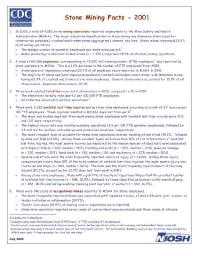Mining Publication: Stone Mining Facts - 2001
Original creation date: July 2003
Authors: National Institute for Occupational Safety and Health
In 2001, a total of 4,282 stone mining operations reported employment to the Mine Safety and Health Administration (MSHA). The major industrial classifications in stone mining are dimension stone (used for construction purposes), crushed and broken stone (aggregates), cement, and lime. Stone mines comprised 29.3% of all mining operations. The median number of operator employees per stone mine was 6.3. Mines producing crushed and broken stone (n = 3,352) comprised 78.3% of all stone mining operations. 2. A total of 69,588 employees, corresponding to 72,070 full-time equivalent (FTE) employees, was reported by stone operators to MSHA. This is a 1.4% decrease in the number of FTE employees from 2000. Stone operator employees comprised 25.7% of all employee hours reported to MSHA in 2001. The majority of stone operator employees worked in crushed and broken stone mines, with limestone mines having 65.9% of crushed and broken stone mine employees. Cement stone miners accounted for 15.1% of all stone miners; dimension stone miners, 10.1%. 3. Three work-related fatalities occurred in stone mines in 2001, compared to 15 in 2000. The stone mine fatality rate was 4.2 per 100,000 FTE employees. All fatalities occurred in surface operations. 4. There were 2,682 nonfatal lost-time injuries among stone mine employees occurring at a rate of 3.7 injuries per 100 FTE employees. These injuries resulted in 110,626 days lost from work. The mean and median days lost from work among stone employees with nonfatal lost-time injuries were 41.2 and 12.0 days, respectively. The highest injury rate was in mill processing operations (3.9 per 100 FTE operator employees), followed by 3.5 and 3.2 for surface and underground production locations, respectively. The most frequent type of accident for stone mine employees involved handling of materials (40.1%), followed by slips and falls (24.6%). Among those accident types with more than 10% of the total number of nonfatal lost-time injuries, the most severe injuries (as measured by the median number of days lost) were associated with slips or falls (n = 660, median = 15.5), handling materials (n = 1,076, median = 12.0), powered haulage (n = 220, median = 10.5), hand tools (n = 283, median = 10), and machinery (n = 275, median = 10.0). Sprains and strains were the most frequently reported nature of injury (n = 1,229). Among those injury categories with more than 10% of the total number of nonfatal lost-time injuries, the most severe injury was fractures and chips (n = 283, median = 33.0). The back was the most frequently reported part of the body injured (22.1%), accounting for 21,711 days lost from work in 2001. Among stone mine employees, those with a job title of mechanic/repairman/helper had the greatest number of nonfatal lost time injuries (n = 586, 21.8%), followed by those classified as laborer/utility man/bull gang (n = 482, 18.0%) and sizing/washing/cleaning plant operator or worker (n = 449, 16.7%). 5. There were 146 cases of occupational illness reported to MSHA for stone employees. The most frequently reported illness was associated with repeated trauma, of which 58 were joint, muscle, or tendon irritation or inflammation (39.7%). Twenty-nine cases (19.9%) of hearing loss or impairment were reported. Stone mine operators reported seven cases of coal workers' pneumoconiosis and three cases of silicosis.

- Coal and metal/nonmetal mining facts - 2008
- Coal and Metal/Nonmetal Mining Facts - 2008 (HTML)
- Coal Contractor Mining Facts - 2001
- Coal Contractor Mining Facts - 2002
- Coal Contractor Mining Facts - 2003
- Coal Contractor Mining Facts - 2004
- Coal Contractor Mining Facts - 2005
- Coal Contractor Mining Facts - 2006
- Mining Fact Sheets
- Rib Falls: A Major Ground Control Issue